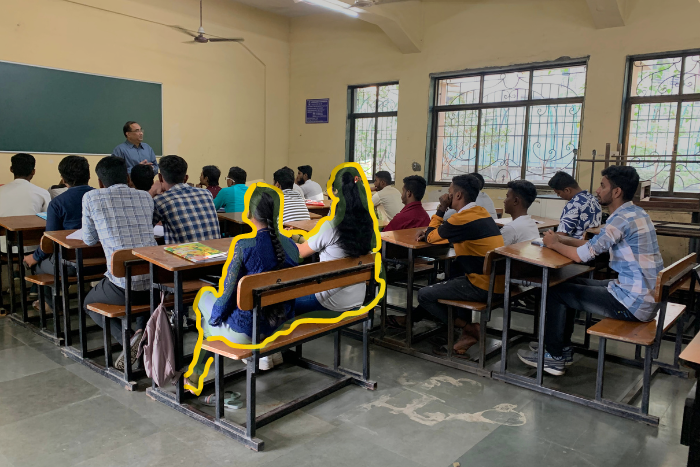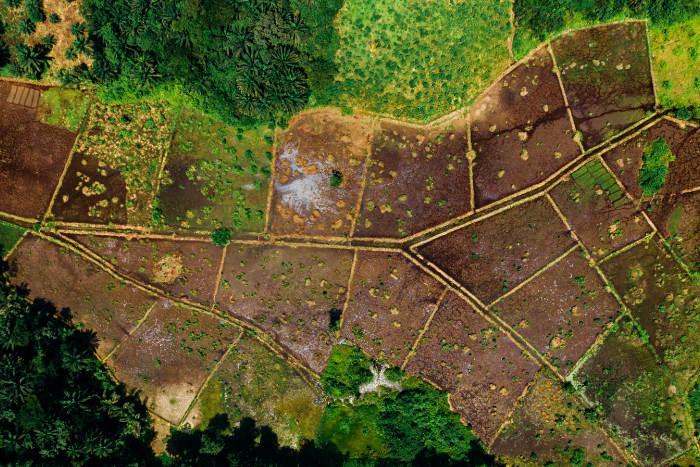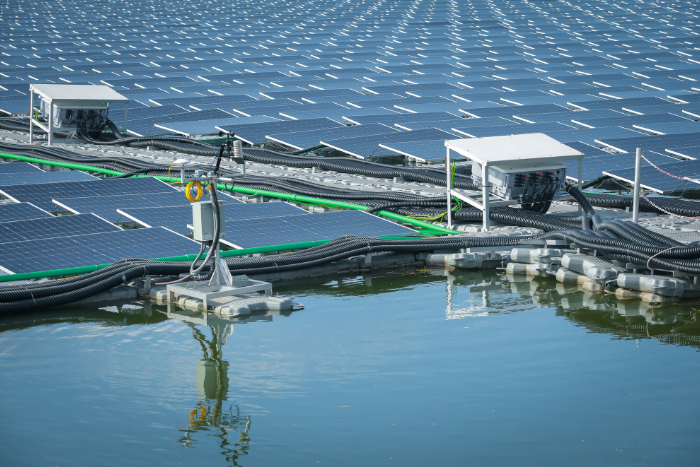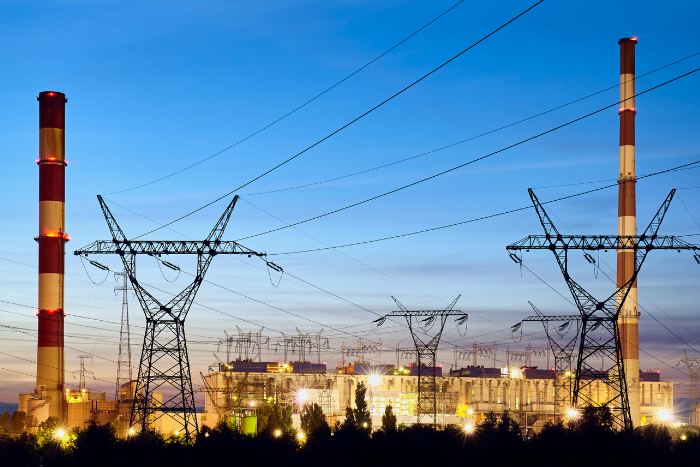


As the issue of unemployment looms large this election season while the country aspires to ensure a just transition, CarbonCopy looks into the Centre’s Suryamitra scheme—launched in 2015—to skill India’s youth to work in the solar industry. A closer look shows that while the national initiative has made progress, it is uneven. Read more
Reports say that India can potentially create about 3.4 million jobs (short and long term) by installing 238 GW solar and 101 GW new wind capacity to achieve the 500 GW non-fossil electricity generation capacity by 2030 goal.
9 years after launch, India’s solar skill training scheme yet to find its place in the sun
As the issue of unemployment looms large this election season while the country aspires to ensure a just transition, CarbonCopy looks into the Centre’s Suryamitra scheme—launched in 2015—to skill India’s youth to work in the solar industry. A closer look shows that while the national initiative has made progress, it is uneven
A solar skill training session is underway in Mumbai. “This is the right time to be here. The solar industry is going to be big. Bohot saare logo ki avashakta hai yaha (a lot of people are needed here),” trainer Santosh Pisat tells his students at a session being held under the Suryamitra Skill Development Programme (SSDP).
Launched in 2015, SSDP is the Centre’s scheme to develop the skills of youth in the solar industry to install, commission, operate and maintain solar energy equipment in the country and abroad. It is free of cost and aims to prepare candidates to become entrepreneurs in the solar industry. The nodal agency for this programme is the National Institute of Solar Energy (NISE), an autonomous institute of the Ministry of New and Renewable Energy (MNRE).
In the classroom, 30 students, many of whom are fresh out of college, are intently listening to Pisat as he maps out seemingly innumerable career opportunities in the solar market. From technical jobs such as designing, installing and maintenance to avenues like marketing, content writing, sales, business development, entrepreneurship, and so on.

Previously an electrical engineer, Pisat took an early retirement and then upskilled to train solar aspirants. Pisat weaves in the Paris Agreement, the Dollar vs Rupee debate, Atmanirbhar Bharat, coal and air pollution, government incentives— all in one thread, eliciting a unified response from the class — “Yes, we want to work in the solar industry.”
Pisat’s presentation promises these budding entrepreneurs the one thing that they all dream of having—a steady income. The grip of unemployment has tightened over India’s youth. The India Employment Report 2024 by the International Labour Organisation (ILO) and the Institute of Human Development (IHD) says that unemployment in India has predominantly been a problem among the country’s young, especially those with a secondary level of education or higher, and it has intensified over time.
In 2022, the share of unemployed youths in the total unemployed population was a worrying 82.9%. The share of educated youths among all unemployed people also increased, from 54.2% in 2000 to 65.7% in 2022.
India’s unemployment rate increased from 7.14% in January 2023 to 7.45% in February 2023, with the total number of jobless people in the country reaching 33 million from 31.5 million in January. The share of unemployed youth, therefore, stood roughly at 27 million and that of educated unemployed at 21 million.
These are extraordinary numbers, but hope shines through the solar sector. Reports say that India can potentially create about 3.4 million jobs (short and long term) by installing 238 GW solar and 101 GW new wind capacity to achieve the 500 GW non-fossil electricity generation capacity by 2030 goal. As per International Renewable Energy Agency’s (IRENA) 2023 report, India had 2,01,400 jobs in grid-connected solar PV in 2022, up 47% from 2021. About 80,600 people work in off-grid solar space.
At a time when India could lean on the solar industry to battle the unemployment crisis, initiatives like SSDP become even more important. As per IRENA, India was ranked number two after China in the number of employment by the solar photovoltaic power segment in 2022. Initiatives like the PM Surya Ghar Yojana—a scheme launched in 2024, which aims to provide free electricity to households who opt to install rooftop solar electricity units— are paving the way for an increased demand of workers skilled in the solar industry.
The Suryamitra scheme, therefore, has got just the right recipe for a just transition—building a solid foundation for India’s clean energy job market, encouraging solar entrepreneurship, promoting gender equality and keeping the underprivileged in focus.
But a closer look at the programme, nine years after its launch, reveals the programme is yet to realise its full potential, much like the youth it aims to uplift.
Building a bright future
The training session CarbonCopy witnessed was part of a CSR initiative run by kWatt Solutions Pvt Ltd—one of the empanelled training partners—in Mumbai. This allows students from varied backgrounds—not just ITI diploma holders—to enrol in the training session. Along with some were fresh graduates with an ITI diploma, some were from marketing, hoping to work with solar firms as content providers. Some had previously worked in the oil and gas industry and were looking to move on to “greener” pastures, while others had already worked in the industry and had joined the programme to brush up their theoretical knowledge to start their own ventures.
One of the students, Rohit Tenkale, has a marketing background. When his friend, a solar vendor, approached him to market his products, Tenkale had to pass. “It was a very good opportunity for me, but because of no knowledge of the field, I missed it. He even tried explaining the basics to me, but it was difficult to understand. So, I thought doing this course will acquaint me with all the basics I need to be able to get a marketing job in this sector.”
Arun Tekha, another student is following his dream of being a PV designer. “I have an MBA in finance. My brother has a solar engineering, procurement, and construction company (Solar EPC). I have been working with him for the past two years and have learnt system designing. I can already design small systems of up to, say, 100KW. I know the potential of the solar sector and that we have a target till 2030. I believe there’ll be a big boom in the industry.” PV design involves figuring out how many panels will be needed to cater to the requirement, how will they be placed given the space, how many arrays will be needed, etc.
But how are these participants selected?
“We [training institutes] reach out to ITI colleges and universities to get access to students enrolled in technical courses to counsel them. Our primary focus remains figuring out which candidate is sincerely looking to explore the solar industry and would be keen to take up a job as we have to ensure placement according to the government requirements. Preference is given to candidates from rural areas,” said Kunal Solanki, training & operation head, kWatt Solutions Pvt Ltd.
Training institutes also advertise in newspapers and social media, inviting candidates to sign up for the course.

Fuelling entrepreneurship and atmanirbharta
After receiving the Suryamitra certification, Sohan Singh, 31, worked a job at a solar EPC for 16 months before venturing out on his own in 2023. In his words, his “expectations were 100% met”. The course and the job that followed taught him how to interact with customers to better understand their needs and the basics of professional dressing, along with the importance of doing a site survey—which he never did before.
Most importantly, his earnings almost doubled. Where he was making about ₹15,000 a month doing electrical and technical jobs, he now makes an average of ₹30,000 a month. “As my income increased, I got my house renovated and bought two bikes. People around me often ask me how I achieved that, they inquire about the Suryamitra course, fees, placement, what all it entailed, etc.,” explained Singh.
Singh’s is not an isolated case.
In July 2022, in the middle of kharif season, a transformer in the village in Rewa, Madhya Pradesh, went bust. Ashish Pandey’s field—spread over five acres— where he had sown paddy, needed water. Pandey, 30, who had received his Suryamitra certification in 2018, took a leave of absence from work in Indore and went to his hometown.
Pandey bought a 3KW solar pump equipment and installed it by himself in his field, saving his crop. Currently, Pandey supervises training centres at kWatt Solutions Pvt Ltd.
SSDP, therefore, has certainly been changing lives, but not for everyone.
Feeling out of place
After receiving certification, candidates are eligible for placements. According to the policy, it is the training partner’s responsibility to get at least 70% of the candidates placed. According to an empanelment invitation released by NISE, the remaining funds to the training partners are released only after verifying that this placement percentage is reached.
The mandate looks good on paper, but not in reality. The renewable energy sector can potentially create a total of 3.5 million jobs by 2030 as per IRENA. Suryamitra has made a decidedly modest start. It has created just 56,087 graduates. Further, as per NISE’s records, the overall placement since the programme started in 2015 till the end of financial year 2023 stands at 48% i.e only 26,967 candidates have been placed out of the total 56,087 trained over the past nine years. It is important to note that this is the record for government-funded training only.
“Some training partners are content with just receiving the enrollment and certification money because they know they can’t achieve a good rate of placement. So they operate without receiving the placement money,” said Byomkesh Mishra, co-founder, Medha, a non-profit organisation working to enhance youth employability and employment opportunities by supporting students in colleges, ITIs, and polytechnics for more than 10 years.
According to Mishra, there are some indicators to look at while assessing such skilling initiatives. They are: enrollment rate— how many were actually enrolled out of the total mobilised candidates; certification rate—how many actually received certification at the end of the program or if there were drop outs; placement rate— how many got a documented job opportunity; and retention rate— where is the candidate after 1 year? Still at a job? In the same industry? “That’s where a lot of wisdom actually lies,” added Mishra while talking about the retention rate.
Based on these parameters, Suryamitra is not delivering on its promises. After almost a decade, why has this scheme only certified 56,087 candidates? And why have only half of them found job placements? The answer to the first question, as the numbers indicate, is seemingly poor implementation, and an inability to attract minority demographics such as women and rural youth, especially in coal-rich states such as Jharkhand. The answer to the second question on poor placements, some say, is impractical training, where theoretical knowledge takes precedence over real-world experience.
Gauging the recruiter sentiment
Multiple sources confirmed that for freshly certified “Suryamitras”, as the certified candidates are called, a typical starting salary ranges between ₹13,000-₹15,000 a month. After six months, this can go up to ₹18,000.
But are solar companies seeking them out?
“Almost all the vendors we work with are graduates from the Suryamitra programme. These certified candidates are theoretically well-acquainted with the subject matter and within 20-30 days on site, they usually become efficient on the practical aspects, including documentation, billing, etc. as well. Within a couple of months, or even sooner, they become independent vendors. These candidates are about twice or thrice as proficient than candidates we directly hire from ITI or Polytechnic colleges,” said Vishal Chaudhary, director, Solars4U, a solar engineering, procurement, and construction company (Solar EPC ) in Ajmer, Rajasthan.
Not all recruiters, however, share the same sentiment. Others think the programme ought to do more to impart practical know-how and application.
“Suryamitra is a theory-heavy course, not very practical. The number of sessions dedicated to practical learnings are less. The curriculum can benefit from more site visits and interaction with potential customers. Since a lot of candidates come from remote and rural areas and lack a certain kind of exposure, they lack presentation skills. But again, it depends on the candidate. We have one Suryamitra graduate working with us and he earns about ₹28,000 per month, which is more than what 60% of my employees make,” said Sumit Agarwal, founder and CEO, Solruf, a Maharashtra-based Solar EPC.
However, what seems to be the norm is that freshly certified candidates join as trainees to gain on-site practical experience. Most of the recruiters and certificate holders CarbonCopy spoke to said that within a year or so, the candidates either venture into starting their own solar business or switch companies to move higher up the ladder.
Missing from the solar scene: Women
Almost everyone that CarbonCopy spoke to said that female participation in SSDP, at best, stood at 10%.
In Pisat’s classroom, Archana Bapu Shelar, 21, and Pranali Ramchandra Bandhane, 22, are the only two women participants.

But even they were told about the programme by the men in their lives.
Bandhane had previously worked with her mama (maternal uncle), who runs his own enterprise as a solar energy vendor, and was recommended to do this course by him to refine her skills and knowledge. She wants to set up her own shop.
Shelar aims to secure a stable job, which she thinks can be found in the booming solar field, or at least that is what her professor, a man, at her ITI college told her when he suggested she enrol in this training program.
The gender problem is not limited to merely enrollment, but extends to recruitment.
“The installation job often requires travelling to remote parts, lifting heavy equipment like inverters and panels, using machinery for drilling, etc. which is more suitable for males. That’s why females are not preferred on the job side. We are encouraged to get more women in the classroom, but during placement it becomes difficult to convince recruiters to accommodate one woman in the team of, say, 20 men. This will mean additional safety regulations. Even women themselves are less interested in these jobs, knowing what is in store for them,” Solanki from kWatt Solutions Pvt Ltd. said.
Sometimes, it is the other way round. The norms for recruitment feed into the enrollment process. In some cases, training partners are recruiters themselves and prefer male candidates during enrollment.
“In addition to the fact that it is a strenuous on-field job, there aren’t many women with ITI diploma holders. Second, it is a residential programme. In order to accommodate merely one or two women, the cost goes up to ensure separate hostels. So we prefer males mostly,” said Rakesh Kumar Choudhary, director, Bugalia International Private Limited. The solar EPC firm operates in Rajasthan and runs the certification programmes in Jaipur and Jodhpur.
Have they trained any women so far? None, he added. However, Choudhary had recently received inquiries from potential employers looking for women with Suryamitra certification for solar panel packaging. This work, according to Choudhary, doesn’t involve any heavy lifting and the workers just need to operate a machine in an air-conditioned room. Such employers are now training women themselves, he said.
Solruf’s Agarwal, however, mentioned that there are about 30% women employees in his company, none of them with SSDP certification though. They mostly work in operations and as account managers and in business development roles where they onboard vendors and work on documentations.
With her diploma degree in Electrical Engineering, Kajal Pagare, completed the SSDP in May 2022. After the training, she was placed as an apprentice with the Brihanmumbai Electric Supply & Transport (BEST) in Mumbai. She worked there for about a year. Now, since the past five months, she has been working as a technical approver at Vashi Integrated Solutions, a company dealing in industrial and commercial supplies.
“Most of the companies take women for PV designing roles. I’ve worked in the field before with BEST and I would say, it’s a tough job. So, now I’ve shifted to a desk job and I’m looking to explore PV designing.”
CarbonCopy couldn’t find any female vendor to speak with who holds a SSDP certification.

Despite encouraging female participation in SSDP, the government data does not provide gender-based details on the number of candidates enrolled and placed under the programme over the past nine years. Gender is not even a lens of bifurcation in the government data.
Is merely mentioning that women candidates are encouraged to apply enough?
“There’s no incentive for these training partners to enrol more women, right? They have to show enrollment numbers and get their work done. This is the norm across such skilling programmes unless the job role is gender defined, like the care industry, hospitality or medical industry where you would find a good number of female candidates. So, this is stereotypically reinforced,” explained Mishra.
The disparity is not limited to women. It extends over states, especially, in the North East India.
Solar ambitions going south in the east
The momentum further drops as we move towards East India. CarbonCopy looked into Jharkhand— the state at the heart of just transition in the country— and found that a mere 876 candidates have been trained since the inception of the programme, according to government data. Out of which only 466 were placed in the coal producing state.
CarbonCopy also spoke to the only training partner in the state and found they are running their second batch so far. So overall, 30 candidates have been certified in 2022-2023 and a batch of 30 is underway. Government data says that there were no candidates trained or placed in 2022-2023, but also that 876 candidates have been trained so far.
Moving on towards the eight states in Northeast(NE) India—Arunachal Pradesh, Assam, Manipur, Meghalaya, Mizoram, Nagaland, Tripura, and Sikkim— the data reveals SSDP had found little success there, with the exception of Assam.
On condition of anonymity, a source involved in the operations team running Suryamitra programmes in one of the NE states spoke to CarbonCopy. According to the source, the state of Suryamitra programmes in most NE states is abysmal.
| State | Estimated Solar Potential (MW) | Installed solar capacity(MW) | Suryamitras trained (2015-2023) | Suryamitras placed (2015-2023) |
|---|---|---|---|---|
| Assam | 13,760 | 112.93 | 1,632 | 866 |
| Tripura | 2,080 | 14.89 | 178 | 57 |
| Manipur | 10,630 | 12.25 | 150 | 50 |
| Arunachal Pradesh | 8,650 | 11.23 | 60 | 0 |
| Nagaland | 7,290 | 3.04 | 60 | 0 |
| Meghalaya | 5,860 | 4.15 | 30 | 0 |
| Mizoram | 9,090 | 7.88 | 0 | 0 |
| Sikkim | 4,940 | 4.65 | 0 | 0 |
| Total | 62,300 | 171.02 | 2,110 | 973 |
Due to the abundance of forest and fire wood in the region, there’s not much awareness on the use of solar energy. Consequently, even the people in administration i.e. the government officials themselves are not aware of the course and the legitimacy of the SCGJ certification.
“We had trained people but even the state government didn’t want to hire those people, not even as interns. Neither were they accepted by private organisations. No one recognises the certification by SCGJ, even people within the government organisations. See, we can create a batch, it is not an issue, people are eager to learn, but do we have avenues to place them? We are helpless,” said the source.
As a result, many of the certificate holders were placed in shopping malls, hotels and local restaurants. Even those who wanted to become vendors themselves found no support from local banks to start the enterprise, again due to the prevailing general lack of awareness of solar energy. Even if there are some odd solar jobs here and there, it is outsourced to professionals in Delhi or Kolkata and locals are not hired.
The current list of 139 registered centres on the NISE website has no centre or training partner to show for Manipur, Meghalaya, Mizoram, Nagaland, Tripura, and Sikkim. This has been updated from a previous list which had 181 centres, with training partners in these states as well.
Did the poor performance of the programme in eastern states resulted in training centres dropping off here?
Training partners a major factor for success
According to Mishra, training partners play a crucial role in running these initiatives and schemes. In his words, “everything depends on the quality of the training partners”—some have deep pockets and some don’t.
So is the success of such schemes solely dependent on training partners?
“The state governments equally implement these schemes because they come from direct ministries. Most of the time, any scheme is as good as the quality of the implementing agency or the training partners. Secondly, it depends on how good the industry interface is with these training partners. So how many employers are connected to them and how many industry partners they have and so on,” answered Mishra.
So, for example, in the eastern states, the mobilisation numbers are very high in such schemes. But the placement rates are dismal because of the lack of industry connect and high dropout numbers. The NGOs from the region have deep connections and they mobilise tribals, but when they come to the city they don’t find it as per their expectation and they go back.
If the destiny of such initiatives depends largely on training partners, shouldn’t policy be made stronger?
Mishra pointed out that taking such courses to the ITIs or polytechnic colleges instead of creating an inefficient value chain could be one way to do it. “Why create a parallel structure outside to run these programs? The government has a huge ITI network and the students there are the right fit for this programme. So, why not have a MOU with these campuses themselves? It is because the ministries work in silos,” he added.
The COVID-setback
The programme has taken a hit after COVID-19 pandemic and seems to be recovering rather poorly from it. CarbonCopy reached out to Amitabh Kant for his comments on the scheme’s progress so far. The copy will be updated when a response is received.
So what is the overall report card for the Suryamitra scheme? “It’s been a short period so I can’t say much. All states are performing okay,” said Dr. Siva Reddy V, Director (Technical) at NISE. In January 2024, he was made the officer for the programme. Turns out, the main officers for programmes at NISE are changed every two years or so. Therefore, the current officer did not have much context about the programme.
As the world marches towards tripling its renewable energy capacity, SSDP needs to plug its loopholes. It has all the elements to succeed. Plugging its loopholes, therefore, will only work to help more such skilling programmes coming up in the clean energy sector to achieve success.
The Supreme Court demanded to know why the state allegedly received only ₹ 3.15 crore to fight the flames, while a demand of ₹ 10 crore was made.
Supreme Court questions Centre, Uttarakhand over forest fires
The Supreme Court questioned the central and the Uttarakhand government about a shortage of funds and the divergence of guards to election responsibilities as the state attempts to suppress hundreds of active wildfires. Stating the “sorry state of affairs,” the apex court demanded to know why the state allegedly received only ₹ 3.15 crore to fight the flames, while a demand of ₹ 10 crore was made. The court then also asked to know why the centre insisted on giving forest officers authority over elections. Some reports claimed that forest officials were appointed on election duty despite orders from The National Green Tribunal (NGT) and other relevant authorities to not do so during the forest fire season. This in turn resulted in poor preparation by the forest department.
La Nina effect may lead to above-normal rain and floods in India
Monsoon that begins in June may witness above average rainfalls and floods as conditions have turned favourable for the La Nina weather phenomenon in the Pacific Ocean to start in the next few months, the Climate Prediction Centre of the National Oceanic and Atmospheric Administration of the US said. The phenomenon could form as early as June-August 2024, with higher confidence during the following seasons, HT reported.
In India, La Nina is associated with a strong monsoon and above average rains and colder winters in the subcontinent. The report said a transition from El Nino to ENSO-neutral is likely in the next month (June). La Nina may develop in June-August (49% chance) or July-September (69% chance), according to NOAA projections. The weather bureau had earlier forecast above normal monsoon at 106% of the long-period average, a year after this number was below normal at 94%.ia
Meanwhile, a massive dust storm (50-60 km/hr winds) that left at least 14 people dead and 74 injured in Mumbai on Monday was the result of ground heating, abundant moisture, and instability in the atmosphere, HT reported.
Stop deforestation, land degradation by 2030: UN forum on forests
Deforestation should be urgently stopped and further degradation of land should be halted by 2030 for the world to stay on the path of sustainable development, the UN Forum on Forests said in a declaration at the conclusion of its 19th session on Friday. India shared its contentious Green Credit Programme at the conference, HT reported.
The declaration reaffirmed the UN Strategic Plan for Forests 2017-30 as a global framework for action to protect and sustainably manage forests and trees outside forests and contribute to the implementation of the 2030 Agenda for Sustainable Development and other international forest-related goals.
At the conference India shared the launch of its Green Credit Programme that provides incentives to entities to take up tree plantation and restoration of degraded forests, the environment ministry said on Sunday. According to the HT report the increase in the country’s ambiguously defined forest cover and the Green Credit Programme are contentious issues as corporations have been allowed to take up plantations on degraded land, including open forest and scrub land, wasteland and catchment areas of water bodies identified by state forest departments, even as environmentalists have pointed out that a lot of such land already has thriving biodiversity, which will now be at risk from plantations.
‘Land Squeeze’: 1% of largest farms control 70% of the world’s farmland, says global study
Around 87% of land grabs in global deals since 2000 have occurred in high biodiversity regions, while major new pressures were emerging from ‘green grabs’ for carbon and biodiversity offset projects, conservation initiatives and clean fuels, revealed a new report by the International Panel of Experts on Sustainable Food Systems (IPES-Food).
The report titled Land Squeeze (released May 13, 2024) exposed the alarming escalation of land grabbing in various forms, opaque financial instruments and speculation, rapid resource extraction and intensive export crop production. The report stated that these ‘green grabs’, for which huge swathes of farmland were being acquired by governments and corporations, now account for 20% of large-scale land deals, despite little evidence of climate benefits.
East and north east India faced warmest April ever recorded
April recorded the warmest night temperatures in eastern and north eastern India since the records began to be kept in 1901. IMD data suggests it was also the second warmest April in the peninsula in terms of maximum, minimum and mean temperatures. The weather office experts attributed one of the main reasons for such unusually high temperatures in pockets and certain states to El Nino and climate change. April saw rather mild weather in the northwest, including capital Delhi, due to back-to-back western disturbances that kept temperatures in check. It was the ninth-warmest April overall for the country, an IMD analysis showed.
Unprecedented April heatwave destroys crucial crops in Bangladesh
An extreme heatwave in April in Bangladesh left farmers reeling under the impact. The heatwave shattered a 76-year record for the most consecutive days of scorching temperatures. The Bangladesh Meteorological Department (BMD) confirmed the grim milestone on April 26, 2024. With temperatures exceeding 40°C, crucial crops have wilted and yields are expected to plummet. The prolonged heatwave destroyed ripe chillies, pulses, sunflowers, almonds and paddy crops, among others, reported DTE. Water reservoirs have dried up, leaving many people without enough water for basic needs like bathing, while obtaining drinking water has become an arduous task. The south-western part of Bangladesh has been hit hardest by this crisis.
75% of Lakshadweep corals experienced bleaching since heatwave began in October 2023
Lakshwadeep’s corals have experienced widespread bleaching since heatwaves began in the region in October 2023 in the sea. ICAR-Central Marine Fisheries Research Institute (CMFRI) said around 75% of the corals have been damaged.
State data suggested a marine heatwave event of moderate category with area of spreading 98.56% has been observed on May 3 over the Lakshadweep coast. And one of moderate to extreme category with an area of spreading 100% has been observed on May 3 over the South Tamil Nadu coast. There was bleaching in the Gulf of Mannar as well, according to CMFRI.
Kerala’s tribal regions face extreme heat
Tribal settlements in the dense forests of Kerala are battling extreme heat, reported the ET. The Kani tribal settlement in Chenampara near Kottoor and situated in the valley of the Agasthyarkoodam Hills is considered one of the coolest spots in Thiruvananthapuram district. However, the situation is far from good in this tribal settlement nestled deep inside the forest.
The residents are unable to bear the heat and are struggling due to a water shortage. There are nearly 28 tribal settlements in the Kuttichal and Kottoor areas, and a water shortage and extreme heat are creating havoc.
An official from the India Meteorological Department said the average temperatures in comparison with the corresponding period last year saw an average deviation of above 4.5°C and an orange alert has to be issued in Palakkad. If the high temperatures recorded on Tuesday continue over the following days, there is a possibility that heatwave alerts or declarations will be issued for the districts of Alappuzha, Thrissur, and Kollam. Deaths due to sunstroke have been reported in Palakkad.
Children pulled from mud as 300 die in severe flooding in Afghanistan
Severe flash floods left more than 300 people dead in Afghanistan, CNN reported, adding that three children have been rescued from mud in the aftermath. The report said this latest natural disaster comes after drought in Afghanistan, and is being seen as an example of a climate crisis hitting those who have least contributed to rising global temperatures. It quotes the UN special rapporteur on human rights in the country saying the floods “are a stark reminder of Afghanistan’s vulnerability to the climate crisis”. The Associated Press says: “The latest disaster came on the heels of a previous one, when at least 70 people died in April from heavy rains and flash floods in the country.”
Heat-related deaths rise by 30% in Europe, says Lancet
According to Lancet report, heat-related deaths per 100,000 people in Europe have risen by 31% between 2003-12 and 2013-2022, the Daily Telegraph reported. The 2024 Europe Report of the Lancet Countdown on Health and Climate Change said new diseases are spreading, the hayfever season is starting earlier and “risky hours for exercise have been expanding into hours beyond the hottest part of the day”.
Indian Ocean temperature anomalies predict long-term global dengue trends
Sea surface temperature anomalies across the northern Indian Ocean can act as an indicator for epidemics of dengue, a mosquito-borne virus that can cause serious illness and death says a new study. By looking at climate data and dengue incidence around the world over 1990-2019, researchers develop a new index based on these temperature anomalies. They find that the index captures both the seasonal patterns and the annual magnitude of dengue epidemics across 24 countries. The authors write that their new index “can potentially enhance the lead time for dengue forecasts, leading to better-planned and more impactful outbreak responses”.
Brazil extreme floods kill 55 people
Days of heavy rainfall in southern Brazil have led to “massive flooding and landslides” in Rio Grande do Sul, Brazil’s southernmost state, killing at least 55 people. Over half of the 497 cities in the state have been affected by the storms, with roads and bridges destroyed in several areas. The storms also caused landslides and the collapse of a hydroelectric dam near the city of Bento Gonçalves, killing 30 people. A second dam in the area was also at risk of collapsing due to rising water levels, reported ET.
Kenya ‘unprecedented’ floods kill over 200 people, experts attribute it to climate change
More than 200 people have been killed and more than 150,000 have been displaced in Kenya due to extreme rainfall and consequent flooding. On April 29, a dam in Nakuru County burst due to excessive precipitation, killing at least 50 people—17 of whom were children. Across the nation, businesses and schools are still closed due to the closure of major roadways. While threats from tropical cyclone Hidaya were rising and were expected to make the matters worse, the cyclone weakened after making landfall last week. Kenya and neighbouring Tanzania managed to avoid significant damage.
East Africa is also one of the most vulnerable regions to extreme weather events associated with climate change. Like in many other parts of the world, climate change has led to increasing frequency and intensity of extreme precipitation and flooding across Africa. The Intergovernmental Panel on Climate Change (IPCC) report noted that climate change is projected to increase the frequency and intensity of heavy precipitation and flooding with additional global warming in East Africa. Under a 1.5°C increase in global temperature, mean annual rainfall is projected to increase. Natural phenomena such as the El Niño-Southern Oscillation (ENSO) and the Indian Ocean Dipole (IOD) affect the rainfall pattern in East Africa. Regarding ENSO, El Niño is currently weakening and approaching a neutral state, while IOD is currently neutral.
Climate campaigners see this agreement on policies to challenge carbon credit projects before and after they are implemented as a historic moment.
UN agrees to carbon market safeguards to tackle green land grabs
Carbon credit developers will be prevented from grabbing land and water resources of people under the new global carbon market norms being set up under the Paris Agreement. Climate Home News reported that at the recent meeting in Bonn, countries and experts from around the world approved an appeals and grievance procedure for the UN’s proposed Article 6.4 carbon crediting mechanism.
Climate campaigners see this agreement on policies to challenge carbon credit projects before and after they are implemented as a historic moment. The outlet reported that the previous UN carbon market—called the Clean Development Mechanism (CDM)—did not have any such procedures. It, and other carbon markets, have been plagued by allegations they have harmed local people and their livelihoods, as well as often not delivering the emissions reductions claimed.
Govt plans IBC revision to tackle climate change-related bankruptcies
The Centre is planning to revise the Insolvency and Bankruptcy Code (IBC) to incorporate environmental claims and liabilities, considering that frequency of extreme weather events disrupting businesses is increasing. Currently, while the IBC recognises various categories of claims and creditors, including those related to environmental liabilities, it does not offer any special treatment for these liabilities, reported Policy Circle.
Globally, governments are acknowledging that climate-related disruptions are an immediate concern, not just a future possibility. A 12-member working group comprising members from the World Bank, INSOL International, and the International Insolvency Institute is spearheading discussions to integrate climate action into insolvency processes, driven by an increase in environmental claims.
Sectors particularly at risk include energy, transport, agriculture, and forestry, as well as businesses reliant on natural resources, which may suffer from scarcity or degradation impacting production.
US, Europe fear of China’s dominance threatens climate fight, says Xi’s envoy
Top US climate change diplomat John Podesta and his Chinese counterpart Liu Zhenmin held their first formal bilateral meetings on May 8 and 9 in Washington, where they discussed how to work together ahead of the COP29 climate summit in Azerbaijan. The US and China discussed Chinese overcapacity in solar and battery manufacturing, steel production and coal power. In a speech in April, Liu had said “US protectionism and unilateralism have further extended the climate change governance gap,” adding that constraints on Chinese solar panels and other technology would increase global costs of the clean energy transition.
In an interview with Bloomberg, Chinese climate envoy Liu said the US and European concerns around China’s dominance in clean-energy technologies “risk stalling the fight against global warming”. The newspaper further quoted Liu saying “we need to maintain low costs, otherwise nobody is going to be able to afford the energy transition.”
Rich and developing countries feud over who should meet climate finance targets
Differences between the rich and the developing countries over who should fund the new climate finance goals are widening, according to the Third World Network, an independent non-profit that is tracking the negotiations at Cartagena in Columbia.
Leaders in November will gather mainly to negotiate a new goal for climate finance, which currently has a floor of a minimum of $100 billion every year after 2025, which is expected to help developing countries transition to a low-carbon future.
The US is reported to have said the New Collective Quantified Goal (NCQG) is “voluntary” for those that “choose to pay”, referring to Article 9.3 of the 2015 Paris climate pact that deals with climate finance.
India, speaking for the like-minded developing countries (LMDCs), said the goal must be in accordance with the principles and provisions of the convention and the Paris Agreement, which is equity and common but differentiated responsibilities and Article 9 of the pact. Article 9 stipulates that wealthy nations shall provide financial resources to assist developing countries to both mitigate and adapt to the impacts of climate crisis.
EU countries approve law to cut trucks’ CO2 emissions
EU countries approved rules that will cut carbon dioxide emissions from trucks and require new heavy-duty vehicles emissions to fall 90% by 2040, Reuters reported. The report says the rules will mean manufacturers have to sell “a large share of fully CO2-free trucks—including electric vehicles and those running on hydrogen fuels”. Interim emissions reduction targets for new sales will be 45% by 2030—up from an existing goal of 30% – and 65% by 2035, it says. The newswire added the trucks are responsible for a quarter of road transport emissions in the bloc. It noted: “In Monday’s vote, only Italy, Poland and Slovakia opposed the policy, while the Czech Republic abstained, an EU official told Reuters. To win Germany’s backing, EU countries last month added a preamble to the law which said the European Commission would consider developing rules in future to count trucks running on CO2 neutral fuels towards the targets.”
The verdict review came after the court was informed that after its order, nearly 55% vehicles still do not have insurance cover.
SC to review its verdict that made pollution certificate mandatory for car insurance
India’s Supreme Court will revisit its 2017 order making the pollution under control certificate (PUC) mandatory to renew third-party motor insurance policy. The verdict review came after the court was informed that after its order, nearly 55% vehicles still do not have insurance cover, which is posing great difficulty for victims seeking settlement of compensation claims in road accidents.
“A right balance has to be struck that vehicles remain compliant with PUC norms and all vehicles must also have insurance cover,” the court stated. The matter is posted for hearing on July 15.
Singh informed the court that the commission for air quality management for Delhi and adjoining areas (CAQM) can be consulted. The 2017 order was passed based on the recommendation of the Environment Pollution (Prevention and Control) Authority, or EPCA, a statutory body.
3,800 tonnes solid waste untreated in Delhi violates fundamental rights of people: SC
The Supreme Court expressed its “horror” over tonnes of untreated solid waste in Delhi and the neighbouring cities violating citizens’ right to pollution-free environment. The top court urged urgent action to curb pollution, reported the HT.
The court said, “What signal are we sending to the world if “3,800 TPD (tonnes per day) of solid waste remains untreated in the Capital.” The Supreme Court flagged the gap in the treatment of solid waste in Delhi and neighbouring cities of Gurugram, Faridabad and Greater Noida.
A court said immediate measures should be undertaken to ensure that the quantity of untreated solid waste does not increase till proper facilities are put in place to treat them.
Faridabad: Green court’s 2018 order to tackle construction waste ignored?
Seven years after India’s green court ordered it to tackle construction and demolition waste, the municipal corporation of Faridabad (bordering Delhi) failed to set up dedicated units to dispose of the construction waste. The NGT, in its order in 2018, had asked civic authorities to implement a project to tackle the problem, but no functional unit could be set up even though four units had been proposed by the civic body.
It is claimed that despite outsourcing the project worth several crores under the PPP mode, the contractor came up with only one unit, which is inoperative due to technical issues, the report said.
Andhra villagers to boycott polls over pollution of air, land and water by ethanol factory
Residents of Gandepalli in Kanchikacherla mandal of NTR district (coastal Andhra Pradesh) have decided to boycott the elections over water and air pollution caused by the Sentini BioProducts Private Limited in their village. They want the ethanol factory in there area be sealed. The 2008 distillery had a production capacity of 125-kilo litre per day (KLPD) which was upgraded (with environmental clearance) \ for setting up a separate ethanol plant of 200 KLPD in April 2023.
Bokka Ravi Kumar Village headman (sarpanch) told The Hindu they have repeatedly writing to the officials regarding crop loss and dust, air and water pollution in the village, and now they have written to the NTR district administration that they would boycott the elections if their demands are not met. A 2022 Lokayukta enquiry revealed that the factory was polluting the irrigation canals and rivers and damaging nearby crops.
Flame retardants in car seats pollute cabin air, pose cancer risk: Study
The use of flame retardants in car seats pollutes the air inside cars with the highly toxic chemicals, putting commuters who spend significant time in cars at the most risk, new research found.
The US-based study checked air inside the cabins of 101 cars from model year 2015 or newer. Virtually all air samples contained 1-chloro-isopropyl phosphate, a flame retardant considered by the US National Toxicology Program to be a potential carcinogen.
Most also showed organophosphate ester flame retardants, which in children are thought to cause asthma, early growth, adiposity and brain damage. Meanwhile, two of the chemicals are listed as California Proposition 65 carcinogens, and people with the highest levels of some flame retardants in their blood have about four times the risk of dying from cancer.
UK ‘net-zero’ project will produce 20m tonnes of carbon pollution, say experts
A multibillion-pound “net zero” project backed by two of the world’s biggest fossil fuel firms will be responsible for more than 20 million tonnes of planet-heating carbon over its lifetime, according to research submitted to the UK government. BP and Equinor’s Net Zero Teesside scheme, to build a new gas-fired power station in north-east England, will use carbon capture and storage (CCS) technology to capture up to 95% of its emissions and bury them beneath the North Sea. But according to evidence submitted to the government, even if the project’s claims for its carbon capture and storage facility prove accurate, the gas power station would still be responsible for more than 20 million tonnes of carbon pollution over its lifetime.
The state of Madhya Pradesh has the maximum potential of 40,117 MWp, followed by Maharashtra with 32,076 MWp.
New study shows India has 207 GW of floating solar potential
Water bodies in India have the technical potential to host 206.7 GW of floating solar capacity, according to an assessment prepared under the Indo-German Technical Cooperation on Innovative Solar (IN Solar). The study used GIS-based data for all bodies of water in India by referencing the Copernicus Programme by the European Commission.
The data set was filtered to include bodies of water with a usable area greater than 0.015 sq km, with 12 months of water availability, while excluding bodies of water in protected zones. An area of 0.015 sq km is required to install 1 MW of floating PV.
The state of Madhya Pradesh has the maximum potential of 40,117 MWp, followed by Maharashtra with 32,076 MWp.
Biden hikes import duties on Chinese EVs from 25% to over 100%, but ‘wont impact China’
The Biden administration is set to announce that it “plans to raise tariffs on Chinese electric vehicle [EVs] imports from 25% to 100%” alongside tariffs on solar products and other clean-energy products. But a Bloomberg report said Biden may quadruple tariffs to 102%, while another stated the move is “mostly symbolic” as Chinese manufacturers are “not reliant on US consumers”.
Xinhua reported that China’s “new energy vehicles” (NEV) production in April totalled 870,000 units, up 35.9% year-on-year, while sales reached 850,000 units, up 33.5%, according to data released by the China Association of Automobile Manufacturers (CAAM).
Rajasthan Invites Bids to Develop 8 GW Solar Projects
The Rajasthan government invited bids to set up 8,000 MW solar power projects in the state. Bidders must submit ₹29,500 as the cost of the document fee and ₹500,000 (~$5,996) + 18% GST as the bid processing fee, Mercom reported, adding that bidders must also furnish an earnest money deposit (EMD) of ₹500,000/MW of the quoted capacity. The outlet said selected bidders must provide a performance bank guarantee of ₹1.2 million (~$14,388)/MW per project at least seven working days before signing the PPA.
The developer’s responsibilities include identifying land, installing and owning the project, and obtaining connectivity, approvals, and interconnection with the STU network.
Bidders must submit a single bid offering a minimum contracted capacity of 4,000 MW in the specified formats, the state norms said, adding that the modules used in the project must be from the latest Approved List of Models and Manufacturers issued by the Ministry of New and Renewable Energy.
Tata eyes rooftop solar subsidy scheme as a billion dollar chance
The Centre’s rooftop solar subsidy scheme for households is a $1 billion-plus business opportunity for Tata Power over the coming three years, as the company looks to corner a fifth of the domestic market for solar modules, the company’s managing director Praveer Sinha said. Tata is eyeing the Prime Minister Surya Ghar scheme, which has target of about 1 crore homes. Tata expects the scheme to generate demand for 25-30 GW of solar modules over its duration. Tata Power wants to cater to 5-6 GW of this demand, he said.
At an estimated price of 20 cents per watt, according to Sinha, this could translate to a business opportunity of $1-1.2 billion ( ₹8,350 crore-₹10,000 crore).
Sinha, who said Tata Power holds 13% of the domestic solar module market, wants to ramp up its share to 20% on the back of its new solar cell and module manufacturing unit in Tamil Nadu.
Solar firms win court case for duty-free imports
In a major win, the Delhi high court ruled in favour of the solar sector dismissing attempts by the revenue department to deny duty-free imports to solar power projects set up in warehouses, reported TOI. The report said the decision brings clarity to the application of the Manufacture and Other Operations in Warehouse (MOOWR) regulations.
Solar power companies filed petitions challenging an instruction issued by the Central Board of Indirect Taxes and Customs (CBIC), which aimed to restrict the use of bonded warehouses for solar power projects. The CBIC contended that the regulations were designed to defer Customs duty and Goods and Services Tax (GST) on goods used in manufacturing processes within warehouses and not imported capital goods. The judgment stated that Section 65 of the Customs Act does not preclude solar power generation from its purview. The regulations under this section were intended to promote various operations, including the use of capital goods in bonded warehouses.
The court declared the CBIC’s instruction invalid, as it imposed constraints not supported by the statutory framework. It emphasized that administrative instructions cannot override legislative provisions or judicially approved licenses. The court highlighted that the statutory position allows for the warehousing of capital goods, including those used in solar power projects.
US approves rule to expand transmission of renewable power
Two years after it was kept under development, the US Federal Electricity Regulatory Commission (FERC) approved a rule to make it easier to transmit renewable energy such as wind and solar power to the electric grid. The Associated Press report said the 1,300-page rule, on transmission grid planning and cost allocation, aims to boost grid resilience to extreme weather, cope with rising demand and accelerate construction of new lines.
Under the new norms, grid operators around the country will have to identify needs 20 years into the future, taking into account factors like changes in the energy mix, the growing number of states that require wind and solar power and the risks of extreme weather, explained the NYT. Grid planners would have to evaluate the benefits of new transmission lines, such as whether they would lower electricity costs or reduce the risk of blackouts, and develop methods for splitting the costs of those lines among customers and businesses, said the newspaper.
The integrated cable management system makes it easier to handle heavy charging guns, while integrated ambient lighting helps to light up dark places and show status from a greater distance.
Exicom launches India’s fastest DC charger for electric vehicles
Exicom, an electric vehicle (EV) charger manufacturer, launched what it claims is India’s fastest DC charger with a range of connector options and power outputs from 60 kW to 400 kW, PV Magazine reported. The DC Fast charger, called the Harmony Gen 1.5, can be swapped and expanded. And the available power can be shared to charge multiple vehicles simultaneously.
The outlet reported that the charger is equipped with an artificial intelligence (AI)-driven remote management system, integrated ambient lighting, and many features focusing on improving the customer charging experience. The integrated cable management system makes it easier to handle heavy charging guns, while integrated ambient lighting helps to light up dark places and show status from a greater distance.
Hyundai Motor Group shifts gears, plans hybrid cars for India
As part of a strategic change to expand beyond electric vehicles and strengthen its position in a significant market, Hyundai Motor Group, a South Korean automaker, intends to introduce its first hybrid automobile in India as early as 2026, Reuters reported. The consortium, which includes Hyundai Motor and Kia Corp, is now testing a hybrid sport-utility vehicle (SUV) that will resemble its best-selling mid-sized Creta SUV in India. In 2026 or 2027, Hyundai, the second-biggest automaker in India, and Kia plan to introduce hybrid SUVs to the market. Their ambitions for EVs in India were likewise on schedule. Hyundai Motor Group said it was “committed to a future of electrified mobility and will optimise product strategies for each market” in a statement provided to Reuters. Hyundai is moving away from its initial strategy of concentrating primarily on battery-driven electric vehicles to hybrids that combine an electric motor and petrol powertrain due to a spike in sales of the hybrid technology in India.
Sixfold increase in global energy storage capacity to enable the world to meet 2030 targets: IEA report
The International Energy Agency (IEA) stated in its first evaluation of the state of play across the whole battery ecosystem that batteries must drive a sixfold growth in global energy storage capacity to enable the world to fulfil 2030 ambitions, after deployment in the power sector more than doubled last year. The report stated in 2023, battery growth surpassed that of nearly all other renewable energy technologies due to declining costs, more innovation, and favourable industrial policies.
Utility-scale battery projects, behind-the-meter batteries, mini grids, and solar household systems all saw rapid development that increased the global capacity of battery storage to 42 GW, an increase of more than 130% year over year. With 14 million new electric automobiles, the deployment of EV batteries climbed by 40% in 2023, making up the great bulk of batteries used in the energy industry. In spite of the fact that lithium-ion batteries are still used in billions of personal gadgets worldwide, the energy industry currently supplies more than 90% of the world’s yearly demand for these batteries, according to the report. One of the fastest price drops in the history of clean energy technology has occurred for batteries, with a 90% decrease in less than 15 years. However, the report noted that costs need to come down further without compromising quality and technology to globally scale up batteries.
Testing for offshore hydrogen begins with the integration of three offshore energy systems
Onshore testing for the PosHYdon pilot project has begun for the first time at InVesta’s facilities in Alkmaar, Netherlands. PosHYdon aims to integrate three energy systems in the Dutch North Sea: offshore wind, offshore gas, and offshore hydrogen. The electrolyser will be moved offshore to the Q13a-A platform, 13 km off the coast of Scheveningen, The Hague, after the onshore testing phase. In the fourth quarter of 2024, the first hydrogen production offshore is anticipated. Hydrogen will be transported to land with gas via an existing pipeline. The facility has the ability to electrolyse saltwater to produce hydrogen by demineralising it.
Record power efficiency achieved for solar cell
Chinese solar module manufacturer LONGi Green Energy Technology Co. has achieved a 27.30% power conversion efficiency for heterojunction back-contact (HBC) solar cells. Under laboratory settings, LONGi’s new silicon HBC solar cells have obtained this efficiency, which has been certified by Germany’s Institute for Solar Energy Research Hamelin (ISFH). The previous world record, which stood at 27.09%, was set by Longi itself at the end of the previous year. At the time, Longi claimed that a novel laser graphics technique that is less expensive than traditional, high-cost photolithography methods was responsible for the outcome.
For the first time, the proportion of coal and lignite in India's total installed capacity fell below 50%.
Share of coal in India’s total installed capacity falls below 50% in FY24: Report
A recent report from the Council on Energy, Environment, and Water (CEEW) stated that the share of coal in India’s total installed capacity fell below 50% for the first time in FY24. According to the research, 71% of India’s 26GW of additional power generation capacity in FY 2023–2024 came from renewable energy sources. India has 442 GW of installed energy capacity in total, of which 144 GW (or 33%) came from renewable sources and 47 GW (or 11%) from hydropower. As a result, for the first time, the proportion of coal and lignite in India’s total installed capacity fell below 50%. The report said nuclear capacity (1.4 GW) was also added in the same fiscal year for the first time since 2017.
Australia commits to gas beyond 2050 despite climate warnings
Australia plans to extract and use gas until “2050 and beyond”, despite global calls to phase out fossil fuels, reports BBC News. Prime minister Anthony Albanese’s government said the move is needed to boost domestic energy supply while supporting transition to net-zero. However, critics argued the move is a rejection of science and pointed to the International Energy Agency’s call for “huge declines in the use of coal, oil and gas” if the world is to meet climate targets. In addition to supporting domestic energy, the policy is based on Australia’s “commitment to being a reliable trading partner”, the article added, as the country is one of the world’s largest exporters of liquefied natural gas.
Shell rakes $7.7 billion in profits in first quarter of 2024, sparks row
Shell, the largest oil and gas company in Europe made, $7.7 billion (£6.1 billion) in earnings in the first three months of the year, more than $1 billion more than analysts had predicted. Shell declared that it would return an additional $3.5 billion to its stockholders as a reward. Reduced operational costs, higher margins from crude and oil products, and refining, according to Shell, were the main drivers of the performance, offsetting reduced trading in liquefied natural gas. However, the impressive numbers also stoked criticism of the business’s climate change initiatives. Think-tanks and activists said the corporation “cannot be trusted to drive the green transition”, while it continues to “rake in huge sums of money” from the sale of fossil fuels. Shell investors are urging other shareholders to approve a resolution at the company’s annual general meeting that calls for the company to take more action on climate change. According to the resolution, the business must match its “medium-term” greenhouse gas emissions goal to the Paris Agreement, which aims to reduce global warming.
In a first, EU proposes sanctions on Russia’s LNG sector
The European Commission has, for the first time, proposed sanctions against Russia’s liquefied natural gas sector, a report by POLITICO said. The restrictions would stop EU nations from re-exporting Russian LNG after they had received it, even if they wouldn’t outright prohibit Russian LNG imports into the EU. The sanctions would also prohibit EU’s participation in future LNG projects in Russia. According to the proposal, this would restrict Russia’s ability to expand its LNG output and, consequently, its income. This is the first time the bloc has taken aim at the wealthy gas industry in Moscow. However, the proposed fines would only have a minimal impact on Russia’s earnings from fossil fuels, the report added, even though targeting LNG represents a substantial change in EU policy. Russian earnings from the highly-cooled gas trade amounted to only 25% of total revenue last year, with the EU being the primary buyer of Moscow’s LNG. Furthermore, experts note that as none of the planned LNG facilities presently ship cargo to Europe, the sanctions would mostly be preventive in nature.
Coal India’s contribution to govt exchequer rises 6.4% in FY24
The state-owned Coal India Ltd. (CIL) contributed ₹60,140.31 crore to the government exchequer in FY24, noting a 6.4% rise compared to the fiscal year 2022–2023, according to the Economic Times. Coal India produces approximately 80% of the country’s coal. According to preliminary data from the coal ministry, the company paid ₹56,524.11 crore to the government exchequer in FY23. In March 2024, the total amount of taxes paid to the government increased by 14.8%, from ₹5,282.59 crore in the corresponding month of FY23 to ₹6,069.18 crore. A maximum of ₹13,268.55 crore of the total ₹60,140.42 crore paid to the government exchequer in FY24 went to the state government of Jharkhand. Other recipients included the governments of Odisha at ₹12,836.20 crore, Chhattisgarh at ₹11,890.79 crore, Madhya Pradesh at ₹6,188.89 crore, among others.













